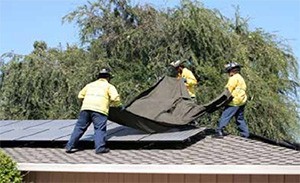 Have you heard of this yet? Well if you haven’t, you’d better take note! The new code (NEC 690.12) is taking effect this year, and several states – including Massachusetts – are already starting to implement it.
Have you heard of this yet? Well if you haven’t, you’d better take note! The new code (NEC 690.12) is taking effect this year, and several states – including Massachusetts – are already starting to implement it.
It says:
PV System Circuits installed on or in buildings shall include a rapid shutdown function that controls specific conductors as follows:
- Requirements for controlled conductors shall only apply to PV System conductors of more than 5 FT inside a building or 10 FT from a PV Array.
- Controlled conductors shall be limited to not more than 30 volts and 240 volt-amperes within 10 SECONDS of shutdown.
- Voltage and power shall be measured between any two conductors and between any conductor and ground.
- The rapid shutdown methods shall be labeled as such: PHOTOVOLTAIC SYSTEM EQUIPPED WITH RAPID SHUTDOWN (in white, capitalized, reflective letters on a red background).
- Equipment that performs the rapid shutdown shall be listed and identified.
Why was this new code created?
First responders (ie. firefighters) must contend with elements of a PV system that remain energized after the AC service disconnect is opened. This rapid shutdown requirement provides a zone outside of which the potential for shock has been mitigated. 10 seconds allows time for DC capacitor banks to discharge.
And we want our firefighters to be safe! As most of the PV systems are very well designed and installed, this is an added precaution to protect those that protect us.
Just to give an example of how this may play out in a real-world situation – firefighters often ventilate a burning structure by cutting a hole in the roof or walls to reduce the chance that smoke gets too thick inside. Now, if there is a PV solar system installed on the roof and the sun is shining, high voltage DC conductors will remain live and energized between the solar panels and the inverter. Even though the firefighters have shut down power to the building, a first respondent could cut right into these live conductors which are often found routed directly under the roof surface or behind exterior walls. Even though firefighters wear insulated clothing that offers protection, coming into contact with 400 volts DC is a serious jolt, a risk they are not prepared to take. Fire fighters have made it clear to the PV industry they want those conductors shut down!
altE is partnering with our preferred supplier – MidNite Solar – to provide products that are up to standard for this new code.
 The central component of the system – the Birdhouse – works in conjunction with MidNite Solar’s disconnecting combiners (those with factory-installed power supply boards), remote trip circuit breakers, high voltage shut-off boxes, and battery disconnect modules. It’s designed to be mounted within 500 meters of the combiner box that is near the panels and located in an accessible location at ground level for first responders. It provides them the ability to disconnect power at the combiner before sending personnel onto the roof. Disconnecting power requires the simple press of a single button! The panel’s LED display gives system status and an automated speech synthesis system gives further situation specific instructions.
The central component of the system – the Birdhouse – works in conjunction with MidNite Solar’s disconnecting combiners (those with factory-installed power supply boards), remote trip circuit breakers, high voltage shut-off boxes, and battery disconnect modules. It’s designed to be mounted within 500 meters of the combiner box that is near the panels and located in an accessible location at ground level for first responders. It provides them the ability to disconnect power at the combiner before sending personnel onto the roof. Disconnecting power requires the simple press of a single button! The panel’s LED display gives system status and an automated speech synthesis system gives further situation specific instructions.
 Now, with this system, emergency responders can de-energize the entire solar array within 10 seconds from a clearly-marked central switch before venturing onto a rooftop for firefighting. Disaster averted! And may the sun continue to shine!
Now, with this system, emergency responders can de-energize the entire solar array within 10 seconds from a clearly-marked central switch before venturing onto a rooftop for firefighting. Disaster averted! And may the sun continue to shine!
See here for an NEC Adoption List, to see what year code your state has adopted. http://www.mikeholt.com/necadoptionlist.php

hi Miguel – With micro inverters (as string inverters), they already satisfy the intent as they turn off when the grid is down. But additionally, it is a proximity issue – with the micro inverter right there at the panel, they are within the required 10ft of the array.
what happen if we instaled micro inverters